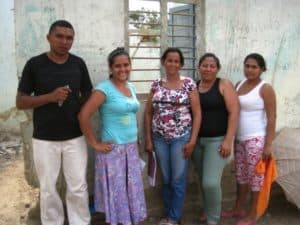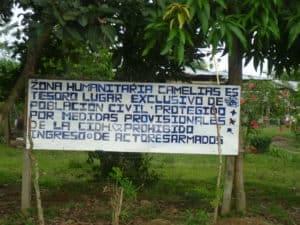4 September marked two years since the official start of the peace negotiations between the FARC guerrillas and the government. From 8 – 14 September partners held a series of events across the country as part of the Week of Peace in Colombia and on 21 September celebrated the International Day of Peace.
Speaking during a recent visit to the UK, as Monsignor Hector Fabio, Director of Pastoral Social, explained: ‘This year marks the 50th anniversary of the conflict in Colombia, which has left more than 200,000 dead; nearly six million people homeless; and since the start of the conflict an estimated 30,000 people have ‘disappeared’. Everyone you meet in Colombia has been affected in some way by the war…[1]
Monsignor Hector Fabio explained how the Church understands that peace is not just forged around international negotiating tables; peace is only sustainable if it is nurtured from the grassroots. During September’s Week of Peace, in support of peace for all Colombians, the Catholic Church has supported the launch of the ‘Soy Capaz’ (‘I am capable’) campaign.
The campaign is supported by other institutions in Colombia, including private sector companies, celebrities, journalists and civil society groups. Colombians have been asked simply to put themselves ‘in the shoes of their ‘opposition’’. The aim of the campaign is to ask people to reflect and consider how they might be able to contribute to bringing an end to the conflict by taking small steps in their daily lives that make a difference.
Local initiatives for peace continue to emerge across Colombia. The Peace Community of San José de Apartadó is a social organisation of over 500 rural farmers in the Urabá region of North-Western Colombia, who were displaced from their lands by a wave of violence between different armed actors in the 1990s and 2000s. They have managed to return to many of their mountain settlements by declaring themselves neutral in the face of the armed conflict, using an interpretation of International Humanitarian Law’s principle of distinction between combatants and civilians.

However, since their foundation in 1997, they continue to face serious risks due to ongoing conflict surrounding large scale commercial interest in their land, as well as reprisals in response to the Community’s struggle to hold human rights violators to account.
Other communities have taken different approaches to building peace and ensuring their rights are upheld. In September 2014 a group of around 2,000 campesinos from the municipality of the Alta Montaña in the Montes de María region of Bolivar formed a ‘human chain’ along one of the main roads.[2] They were asking for guarantees of no repetition relating to land restitution and the Victims and Land Restitution Law 1448 following continued threats and security issues faced by members of the communities’ organising committees.
They were also demanding the fulfilment of 60 per cent of the agreements made during the roundtable discussions held with the government in April 2013 in San Jacinto, as well as the release of campesinos who they believe have had trumped-up charges made against them in the region.
The Women, Peace and Security Collective for Reflection and Action (El Colectivo de Pensamiento y Acción Mujeres, Paz y Seguridad) have come together to create a 15-point Ethical Pact for Peace in Colombia. The Pact is a proposal for beginning to transform social and political attitudes in Colombia, and ultimately working towards a sustainable peace.

The Collective consists of women from across sectors of Colombian society, who believe Colombian society should ‘exercise peace as a right and a collective responsibility, assuming social, political, economic, ethnic, gender and generational differences, but insisting it be resolved in the civil and democratic arena’.
Meanwhile Afro-Colombian communities in Curvaradó and Jiguamiandó have set up Humanitarian Zones, whilst others like the communities in Buenaventura have set up humanitarian spaces. Both of these are designed to try to protect the communities and their land/ homes in the midst of an ongoing conflict and high levels of violence.
The Humanitarian Zones are delineated areas set up close to the original homes from which the communities have been forcibly displaced; they are a bid to peacefully recover their land and livelihoods. The communities living within the Humanitarian Zones refuse to use arms or permit any armed actor to enter the Humanitarian Zone. In order to support them in this they have received special protection measures from the IACHR.
More information
- Read ABColombia’s article ‘Colombian Victims call for Immediate Ceasefire and Integral Reparation’ (September 2014)
- Read ABColombia’s report: ‘Colombia: Women, Conflict-related Sexual Violence and the Peace Process’ (November 2013) in English and Spanish
- Read ABColombia’s report: Civil Society Speaking Out: Agendas for a Sustainable Peace in Colombia
- Read ABColombia’s report: ‘Civil Society Voices: Agendas for Peace in Colombia’ in English and Spanish
Notes:
[1] Colombia: Giving peace a chance, ICN, 22 September 2014
[2] Con cadena humana, habitantes de Alta Montaña exige liberación de campesinos, El Espectador, 8 September 2014
